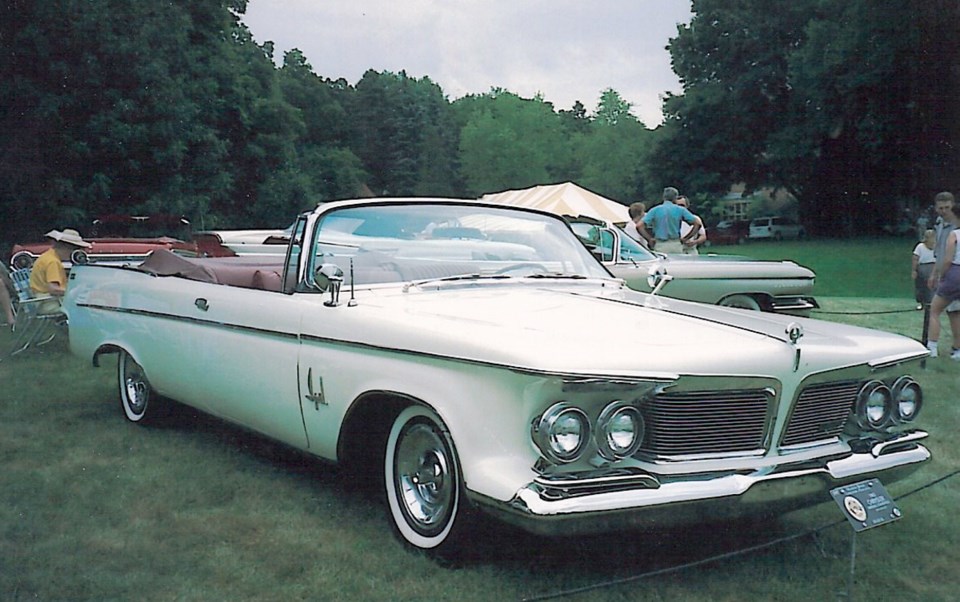The Chrysler Imperial name was first used on a 1924 Chrysler made by the Maxwell Motor Corp. the year before Walter P. Chrysler turned Maxwell into Chrysler Corp.
The Imperial always represented something special in Chryslers. Examples include those grand early1930s Chrysler Imperial Le Baron-bodied dual cowl phaetons, and the 1946-48 Crown Imperials whose massive grilles and broad-shouldered fenders exuded invulnerability.
But no matter how grand the Chrysler Imperial, it didn’t quite match Cadillac in the luxury market. While the Imperial name lost cachet in the 1930s, Cadillac stayed the course, consolidating its position in the midst of the Depression with magnificent V-12 and V-16 engines.
Cadillac got through those perilous times with the help of the lower-priced LaSalle, which didn’t dilute Cadillac’s prestige as others such as the cheaper Packard 120 did to Packard. Cadillac emerged after the Second World War as the undisputed American luxury king.
In the mid-1950s, Chrysler Corp. decided to challenge Cadillac’s luxury-car status. It started with Chrysler’s all-new 1955 “Forward Look” styling theme that ended years of conservative design, a legacy of the controversial and poorly received 1934-1937 Airflow models.
To indicate the seriousness of its quest, Chrysler Corp. created a separate Imperial Division in 1954 and broke out Imperial as its own marque in 1955. Chrysler wanted everyone to know the Imperial was special, and advised licensing authorities it was no longer a Chrysler Imperial. It was now an Imperial, period.
The new Imperial was handsome and substantial. Its two-piece eggcrate grille was formed of thick vertical and horizontal bars. At the rear was its outstanding feature, free standing, fender-top “gunsight” taillamps, a styling theme used in various forms until 1962.
Power came from a 5.4-litre, 250-horsepower “Hemi” V-8. The regular Imperial (not the even bigger Crown Imperial) rode on a 3,302-millimetre wheelbase and it weighed about 2,041 kilograms. Wheelbase would rise to 3,378 mm in 1956, then fall back to 3,277 mm in 1957.
As would be expected, the Imperial was lavishly equipped, including Chrysler’s PowerFlite two-speed automatic transmission with dash-mounted lever, power steering that Chrysler had pioneered in 1951, and power brakes, windows and seats. Air conditioning was still optional.
For 1956, a larger cylinder bore raised horsepower to 280. The automatic transmission now had dash-mounted pushbuttons and it got the corporation’s 12-volt electrical system. Front styling was largely carryover, but the rear fenders rose into modest fins, still with the taillamps perched on top.
1957 was a breakout year. The Imperial got an exclusive new body with higher fins and curved glass windows, an American industry first. The gunsight taillights were now in the fins rather than free-standing.
Underneath, front coil springs were replaced with the corporation’s new longitudinal torsion bars, and the V-8 was now up to 6.4 litres and 325 horsepower. It had Chrysler’s new three-speed TorqueFlite automatic transmission.
The next two years would see the Imperial receive refinements, mostly new grilles, and in 1960 it got revised sheetmetal.
Chrysler had begun phasing out the Hemi engine in 1958, and with the horsepower race in full swing, the 1959 Imperial got a new non-Hemi “wedge head” 6.8-litre, 350-horsepower V-8.
For 1961, the Imperial received a “new-old” styling feature: four free-standing, pedestal-mounted headlamps in alcoves nestled under fender “eyebrows.” They were intended to emulate the classic look of the 1930s. At the rear, the taillamps were now suspended from much more prominent tailfins.
Free-standing headlamps continued into 1962 along with a new split grille. The gunsight taillamps had again migrated to the tops of the toned-down fins.
The Imperial went into 1963 largely unchanged, except for the loss of the fins and distinctive taillamps. For 1964, it got new styling that was somewhat reminiscent of the lovely 1961 Lincoln Continental, the result of Chrysler hiring Lincoln stylist Elwood Engel away from Ford. This design lasted until it was redone for 1967.
As the decade progressed, Imperials began looking less distinctive and more like dressed-up Chryslers. The Imperial had never come close to matching Cadillac sales, and in 1970, Chrysler bowed to the inevitable and discontinued Imperial’s individual-marque status. They were once again Chrysler Imperials.
The Imperial was a brave but futile attempt by Chrysler Corp. to dethrone Cadillac from its perch atop the American luxury car pedestal. That would eventually occur, but would be done by the Europeans and Japanese.
Perhaps fittingly, one of the companies that did it, Daimler-Benz of Germany, builder of Mercedes-Benzes, purchased Chrysler in 1998 and became DaimlerChrysler.
After this less-than-stellar marriage, DaimlerChrysler sold control of Chrysler in 2007. It has since amalgamated with Italy’s Fiat as Fiat Chrysler Automobiles.



